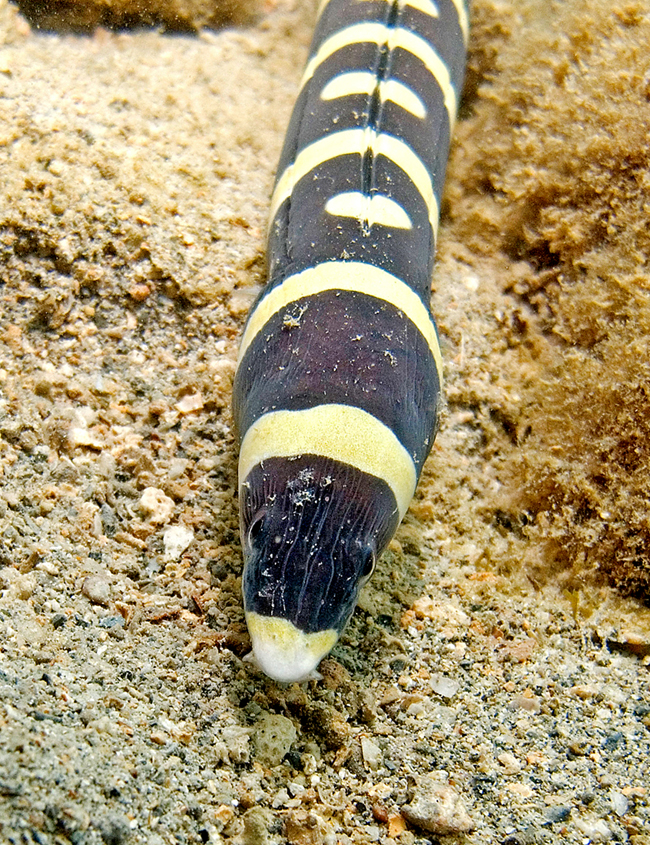Convict Snake Eel, Leiuranus versicolor (Richardson 1848)

Head of a Convict Snake Eel, Leiuranus versicolor, at Sylphs Hole, in the lagoon at Lord Howe Island, Tasman Sea. Source: Andrew J. Green / Reef Life Survey. License: CC BY Attribution
Summary:
A moray with a bold pattern of alternating black and white to pale yellow bars, the black bars being about twice the width of the white bars. Some black bars may completely encircle the body, and some may contain small white saddles. Adults usually have the dark bars notched dorsally by a narrow white to yellow bar or slit.
Cite this page as:
Bray, D.J. 2021, Leiuranus versicolor in Fishes of Australia, accessed 27 Jun 2025, https://fishesofaustralia.net.au/Home/species/2895
Convict Snake Eel, Leiuranus versicolor (Richardson 1848)
More Info
|
Distribution |
Low Isles to Hervey Bay, Queensland; also the Lord Howe Province and Norfolk Island in the Tasman Sea. Elsewhere the species occurs in the tropical, west Pacific. Inhabits inshore sandy areas. |
|
Features |
Head and trunk slightly shorter than tail; head length about 13 in TL; body depth about 46 in TL; anterior nostril a short tube; posterior nostril opposite front edge of eye; upper jaw projecting beyond lower jaw; teeth in jaws uniserial or irregularly biserial at middle of upper jaw; intermaxillary with about nine teeth. Dorsal fin low, origin above middle of pectoral fin |
|
Similar Species |
The Saddled Snake Eel, Leiuranus semicinctus, has evenly-spaced dark saddles along the body, vs L. versicolor having alternating black and white to pale yellow bars, with the black bars being about twice the width of the white bars (some bars completely encircle the body, and some may contain small white saddles). |
|
Etymology |
The specific name is from the Latin versicolor (= variegated, variously coloured) in reference to the 27 purplish-brown rings, which are further divided: "The body is varied by 27 purplish-brown rings, considerably broader than the area between them; most of the rings are further divided more or less completely by narrower white lines or imperfect circles" (Richardson 1849). |
|
Species Citation |
Ophisurus versicolor Richardson 1848, Ichthyology of the voyage of H. M. S. Erebus & Terror Vol. 2: 103. Type locality: Molucca Islands, Indonesia (as Maluku). |
|
Author |
Bray, D.J. 2021 |
|
Resources |
Convict Snake Eel, Leiuranus versicolor (Richardson 1848)
References
Allen, G.R., Hoese, D.F., Paxton, J.R., Randall, J.E., Russell, B.C., Starck, W.A., Talbot, F.H. & Whitley, G.P. 1976. Annotated checklist of the fishes of Lord Howe Island. Records of the Australian Museum 30(15): 365-454 figs 1-2
Allen, G.R. & Erdmann, M.V. 2012. Reef fishes of the East Indies. Perth : Tropical Reef Research 3 vols, 1260 pp.
Francis, M. 1993. Checklist of the coastal fishes of Lord Howe, Norfolk, and Kermadec Islands, southwest Pacific Ocean. Pacific Science 47(2): 136-170 figs 1-2
Francis, M.P. 2019. Checklist of the coastal fishes of Lord Howe, Norfolk and Kermadec Islands, southwest Pacific Ocean. figshare. Collection. https://doi.org/10.6084/m9.figshare.c.4428305.v2
Fraser-Brunner, A. 1934. A new species of the eel genus Ophichthus Ahl. Annals and Magazine of Natural History 10 13(42): 465-468 1 fig. (described as Ophichthus cyclorhinus)
Hibino, Y., Ogata, Y., Endo, S., Wada, M., Murase, A. & Mochioka, N. 2019. First records of a rare snake eel, Leiuranus versicolor (Anguilliformes, Ophichthidae) from Japan. FishTaxa 4(3): 145-149 See ref online
Kaup, J.J. 1856. Catalogue of Apodal Fish in the Collection of the British Museum. London : British Museum 163 pp. 19 pls. (as Elapsopis versicolor)
McCosker, J.E. 1977. The osteology, classification, and relationships of the eel family Ophichthidae. Proceedings of the California Academy of Sciences 41(1): 1-123 figs 1-45 See ref at BHL
Munro, I.S.R. 1957. Handbook of Australian Fishes. No. 11. Australian Fisheries Newsletter 16(5): 45-48 (as Cyclophichthys cyclorhinus)
Richardson, J. 1848. Ichthyology. 75-139 pls 42-43 & 44 (parts), 45-52, 53 in Richardson, J. & Gray, J.E. (eds). The Zoology of the Voyage of H.M.S. Erebus and Terror under the Command of Captain Sir James Clark Ross, R.N., F.R.S., during the years 1839–43. London : Smith, Elder & Co. Vol. 2 139 pp. See ref online
Smith, D.G. & McCosker, J.E. 1999. Family Ophichthidae. pp. 1662-1699 in Carpenter, K.E. & Niem, V.H. (eds). The Living Marine Resources of the Western Central Pacific. FAO Species Identification Guide for Fisheries Purposes. Rome : FAO Vol. 3 pp. 1397-2068.
Whitley, G.P. 1951. Studies in Ichthyology No. 15. Records of the Australian Museum 22(4): 389-408 figs 1-14 (as Malvoliophis (Cyclophichthys) cyclorhinus)



